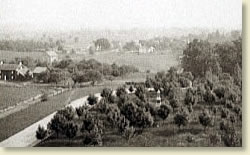|
The Battle of Gettysburg, 1863
Lee's second
invasion of
the North |
On June 24, 1863, General Robert E. Lee led his Confederate Army across the Potomac River and headed towards Pennsylvania. In response to this threat President Lincoln replaced his army commander, General Joseph Hooker, with General George Mead. As Lee's troops poured into Pennsylvania, Mead led the Union Army north from Washington. Meade's effort was inadvertently helped by Lee's cavalry commander, Jeb Stuart, who, instead of reporting Union movements to Lee, had gone off on a raid deep in the Union rear. This action left Lee blind to the Union's position. When a scout reported the Union approach, Lee ordered his scattered troops to converge west of the small village of Gettysburg, Pennsylvania.
 |
Gettysburg at the time of the battle
|
On July 1, some Confederate infantry headed to Gettysburg to seize much-needed shoes and clashed west of town with Union cavalry. The Union commander, recognizing the importance of holding Gettysburg because a dozen roads converged there, fought desperately to hold off the Rebel advance. Other Union troops briefly stopped some Rebels north of town. During heavy fighting, the Confederates drove the Union troops through the streets of Gettysburg to Cemetery Hill south of the town. Lee ordered General Richard Ewell, now commander of the late Stonewall Jackson's old units, to attack this position "if practicable", a vague order that Jackson normally took to mean launch an all-out attack. Ewell was not Jackson. He decided not to attack once he saw the Union artillery atop the hill. Had he attacked and succeeded, it might have changed the course of the war.
The rest of the armies arrived that first night. The Union army established a defensive position resembling a fish hook, with Culp's Hill and the two Round Tops anchoring each end. Lee decided to attack both flanks the next day. On his right flank, Union troops mistakenly shifted out of position, leaving Little Round Top undefended. At the last moment, a Union general rushed troops in just ahead of the charging Confederates. After a long day of fighting, they barely held the position. The misplaced bluecoats were pushed back through The Peach Orchard, The Wheat Field, and Devil's Den. On the left, Ewell's assault failed due mainly to his poor leadership.
Thinking the Union center had weakened from these attacks, Lee decided the next day to hit it first with artillery, and then an infantry charge led by George Pickett's division. Stuart's late-arriving cavalry was to come in behind the Union center at the same time, but they were held off by Union cavalry led by a young General George Custer. After an hour's duel, Union artillery deceived the Confederates into thinking their guns were knocked out. Then 13,000 Rebels marched across the field in front of Cemetery Hill, only to have the Union artillery open up on them, followed by deadly Federal infantry firepower. Scarcely half made it back to their own lines. In all, Lee lost more than a third of his men before retreating to Virginia. Meade, a naturally cautious man, decided the loss of one-quarter of his men had been enough, and only feebly tried to pursue Lee, missing an opportunity to crush him.
Tillie Pierce was born in 1848 and when the battle began, had lived all her life in the village of Gettysburg. Her father made his living as a butcher and the family lived above his shop in the heart of town. Tillie witnessed the entire battle and published her observations twenty-six years after the event.
Tillie attended the "Young Ladies Seminary" a finishing school near her home. She was attending school on June 26 when the cry "the Rebels are coming!" reverberated through the town's sleepy streets:
"We were having our literary exercises on Friday afternoon, at our Seminary, when the cry reached our ears. Rushing to the door, and standing on the front portico we beheld in the direction of the Theological Seminary, a dark, dense mass, moving toward town. Our teacher, Mrs. Eyster, at once said:
'Children, run home as quickly as you can.'
"It did not require repeating. I am satisfied some of the girls did not reach their homes before the Rebels were in the streets.
"As for myself, I had scarcely reached the front door, when, on looking up the street, I saw some of the men on horseback. I scrambled in, slammed shut the door, and hastening to the sitting room, peeped out between the shutters.
 |
Confederate prisoners
at Gettysburg
|
"What a horrible sight! There they were, human beings! Clad almost in rags, covered with dust, riding wildly, pell-mell down the hill toward our home! Shouting, yelling most unearthly, cursing, brandishing their revolvers, and firing right and left.
"I was fully persuaded that the Rebels had actually come at last. What they would do with us was a fearful question to my young mind.
"Soon the town was filled with infantry, and then the searching and ransacking began in earnest.
"They wanted horses, clothing, anything and almost everything they could conveniently carry away.
"Nor were they particular about asking. Whatever suited them they took. They did, however, make a formal demand of the town authorities, for a large supply of flour, meat, groceries, shoes, hats and (doubtless, not least in their estimations), ten barrels of whisky; or, in lieu of this five thousand dollars.
"But our merchants and bankers had too often heard of their coming, and had already shipped their wealth to places of safety. Thus it was, that a few days after, the citizens of York were compelled to make up our proportion of the Rebel requisition."
|






